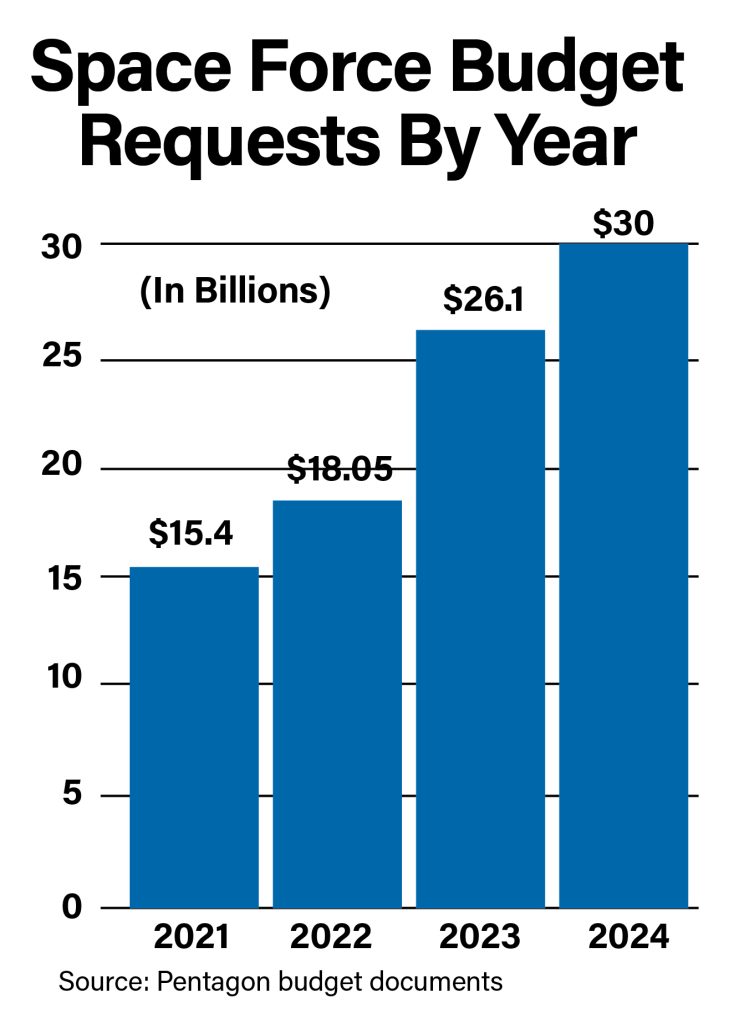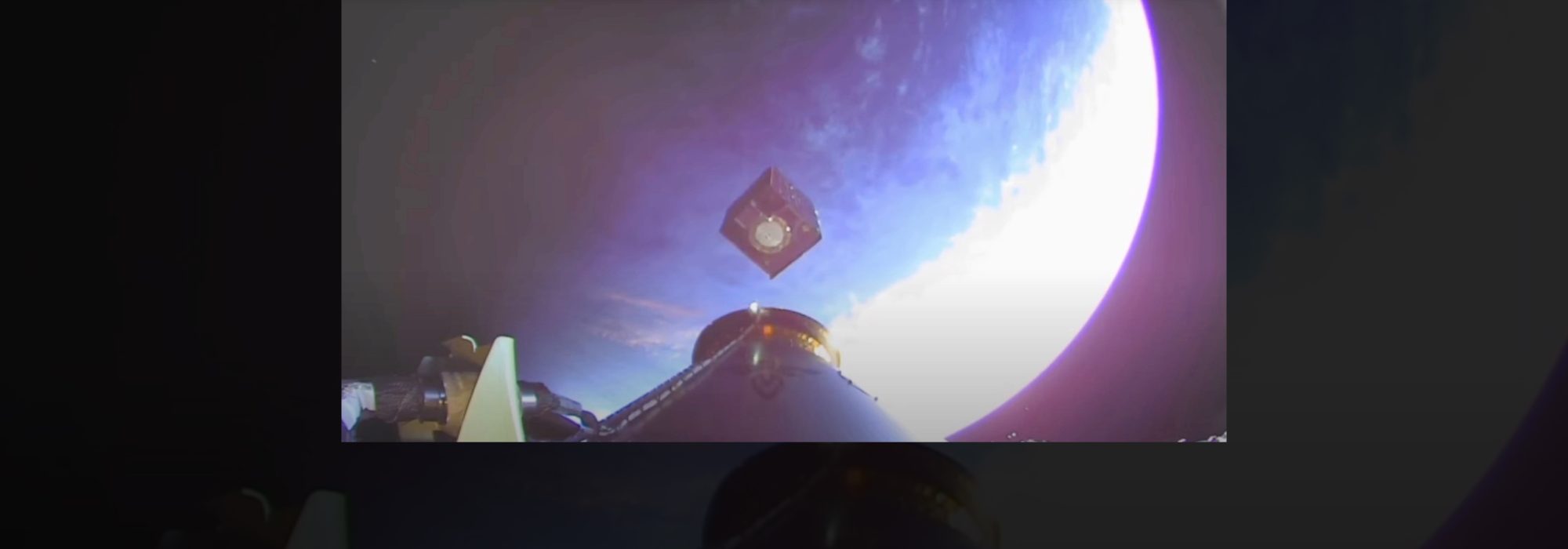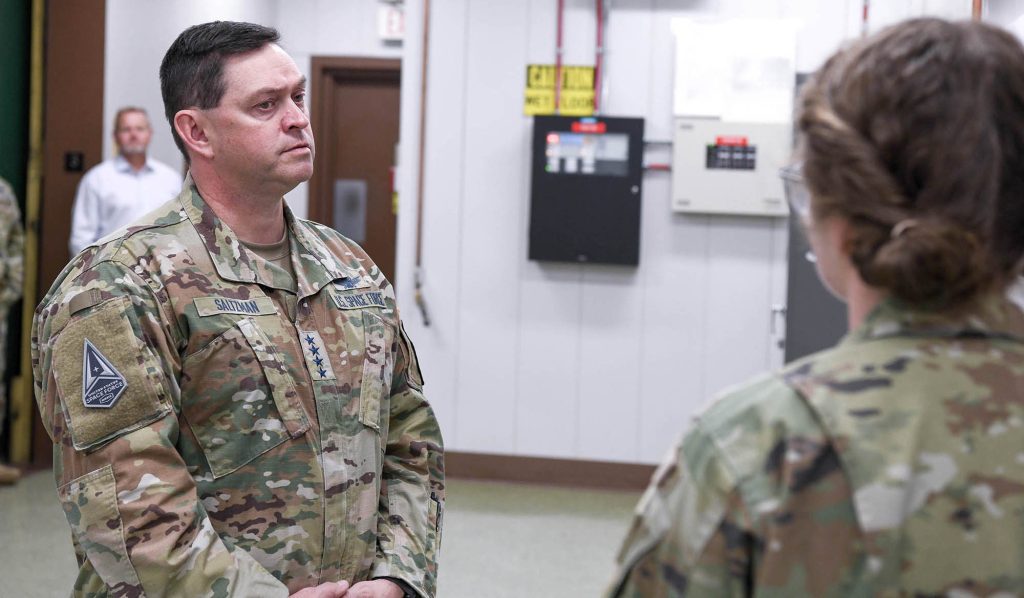By David Roza
Likening the record-breaking trek from order to launch of a satellite in September to Chuck Yeager breaking the sound barrier in 1947, Chief of Space Operations Gen. B. Chance Saltzman said the 57-hour turn-around will have lasting implications for how quickly the Space Force can respond to future threats.
“Now the question is, how do we take advantage of that?” Saltzman said Oct. 18 at the Center for a New American Security. “Chuck Yeager breaks the sound barrier. Big deal, it’s one airplane, what are you going to do with it? [But actually,] it opens the door, it shows the capability, it shows what you can do, it shows how you do it.”
Dubbed Victus Nox, the record-setting Sept. 14 launch from Vandenberg Space Force Base, Calif., demonstrated a concept unheard of in the days of behemoth satellites that took a decade or more to develop. Less than a year earlier, Space Systems Command signed up Millennium Space Systems and Firefly Aerospace to build a satellite for USSF’s Space Domain Awareness mission. The aim was to build it quickly and then be ready to take the finished product and get it to the launchpad and into a launch vehicle within 60 hours. Then the waiting began.
“We built a satellite in less than a year and put it in a warehouse,” Saltzman said. “And it sat there in a warehouse until we gave an order, and when we gave the order, it had to be ready to launch, on the launch pad, within 60 hours after getting the order. They did it in 57.”
Next, launch crews were told to wait again for a launch order, at which point they had 24 hours to get the satellite into space. They missed by three hours, due to a last-minute weather hold, Saltzman said. But the satellite was ready to be “checked out and operational in 48 hours” after reaching orbit, achieving the overall objective of going from sitting in a warehouse to being on-orbit and mission-capable in a week.
“Think about the contracting work that had to go in place, think about the airlift to get the satellite in place, think about the infrastructure and the telemetry of the launch facility, make sure that’s all squared away, all the safety checks that had to be done, the payload integration,” Saltzman said. “I mean, these are massive checklists that have to be run. And for those that haven’t been in the launch business, I don’t think you can fully appreciate all the work that goes into that.”
The test proves a capability that will be essential for making the U.S. Space Force and its architecture more resilient. Part of that resilience lies in forming proliferated constellations of satellites, where there are too many targets for an adversary to realistically destroy. Another part is being able to quickly backfill constellations if satellites are attacked, damaged, or lost.
“From the warehouse to an on-orbit capability in a week: That’s tactically responsive,” Saltzman said. “That’s something that you can [use to] respond to irresponsible behavior on-orbit and the response is directly connected to that irresponsible behavior.”
The CSO said the Space Force was able to pull off Victus Nox because it could make decisions as an independent service.
“The Air Force didn’t have time to put service-level focus on something like this,” he said. “They had other things to worry about.”
Next up for Saltzman is to operationalize this rapid capability. “Now you start talking about ‘how do you build a unit that can do this on a repeatable basis?’” Saltzman said. “How do you do the training? How do you put contract vehicles in place through this augmentation reserve capability?”
The aim, he said is to “put all that together so it’s operationalized, not just a demonstration capability.”
A Space Force Strategy Emerges, But It’s Mostly Classified
By Unshin Lee Harpley and Tobias Naegele
The Department of the Air Force’s Comprehensive Strategy for the Space Force, required by the 2023 National Defense Authorization Act, spells out in broad terms the objectives of the U.S. Space Force, but most of the details are in the unreleased classified version of the report and remain hidden from public view.
AFA advocated for the legislation requiring the report.
“We are excited to see a clearly delineated strategy that draws together the many initiatives driven by Chief of Space Operations Gen. B. Chance Saltzman,” said AFA President and CEO Lt. Gen. Bruce “Orville” Wright, USAF (Ret.). “This is precisely what the Space Force has needed and General Saltzman and his Space Force team are now well positioned to argue their case for the resources and support they need to ensure the United States remains a dominant force in space for the freedom and security of all who love freedom, wherever they are throughout the world.”
The strategy affirms the Chief of Space Operations as the “Force Design Architect for Space Systems of the Armed Forces,” making Saltzman “responsible for presenting coordinated recommendations to the [Secretary of Defense] regarding space-mission force design options to satisfy the requirement of the Joint Force and the Armed Forces,” the strategy states. For resourcing, it notes that the Joint Requirements Oversight Council has designated the USSF as the integrator for DOD’s Joint Space Requirements. As a result, “The Force Design Architect and Joint Integrator now can bring the entire joint community together to develop cogent space requirements,” the strategy states.

One surprise in the report is a projection of reduced investment in future years. The strategy includes a chart showing the service’s projected budget broken down by mission area over the future years defense program—from fiscal 2024 through 2028. The Space Force’s 2024 budget request is for $30 billion, with investments in missile warning systems, GPS, and launch vehicles. That figure declines slightly in 2025 and 2026 before rising sharply again in 2027.
The chart indicates reduced spending for the coming years in areas such as Missile Warning/Missile Tracking and classified programs, which a spokesman said is the result of several systems transitioning from development phase into operational readiness following completion of prototype demonstrations.
Last year, lawmakers expressed concerns about the Space Force’s capacity to sustain its ambitious plans and growth, particularly regarding missile warning and missile tracking and asked for a new cost estimate by January 2023.
In June, then-Vice Chief of Space Operations Gen. David D. Thompson warned of leaner spending and its potential to slow Space Force modernization.
“Either the department may need to look at its priorities for various investments, or we will have to throttle the growth that we have seen and the delivery of capabilities,” Thompson said during a livestreamed event by Mitchell Institute for Aerospace Studies. “It will simply be incumbent on us to make sure that our leaders inside the Department of Defense and in the White House and Congress understand the risks we’ll take if in fact we cannot continue that.”
Like the rest of the Pentagon, the Space Force continually revisits its five-year plan and offers updates alongside its budget submissions.
New Deltas to ‘Streamline Feedback’ Between Operations, Acquisition
By Greg Hadley
A month after revealing prototype “Integrated Mission Deltas” to combine operations and sustainment under one roof, Chief of Space Operations Gen. B. Chance Saltzman announced he’s creating corresponding “System Deltas” to refine USSF organization still further.
The new units are part of Saltzman’s push to align the Space Force around missions rather than functions. In a servicewide ‘C-Note’ sent Oct. 13, Saltzman described the effort as “Forging a Purpose-built Space Service.”
As with the Integrated Mission Deltas, the Space Force will begin with two prototype System Deltas, one focused on electronic warfare and the other on position, navigation, and timing.
Just as the mission deltas fall within Space Operations Command, including their own sustainment and upgrade personnel who used to be in Space Systems Command, the new System Deltas also combine personnel from different areas. Focused on developing and acquiring new capabilities and systems, these units will be part of Space Systems Command, Saltzman wrote, but have close ties with their mission delta counterparts to “streamline the feedback” from operators to acquirers.
But close ties should not suggest the deltas will be physically co-located. A Space Force spokesperson told Air & Space Forces Magazine that the System Deltas and the Integrated Mission Deltas will instead seek to better coordinate their efforts by eliminating what Saltzman calls “organizational seams.”
“There are no perfect organizational structures,” Saltzman said at AFA’s Air, Space & Cyber Conference in September. “The structuring of people to do their jobs will always create seams. The key is to arrange the organization to maximize performance around what matters most and minimize the negative integration effects that seams naturally create.”
Creating System Deltas as a direct counterpart to Integrated Mission Deltas will mitigate the seams between these functions by cutting down on the bureaucratic process by which operations and acquisition personnel typically communicate wants and needs, the spokesperson added.
The two Integrated Mission Deltas officially stood up Oct. 12, as the electronic warfare sustainment offices moved to Space Delta 3, Space Operations Command’s EW Space Delta. The other new mission delta, focused on position, navigation, and timing, is entirely new, and was built by drawing operators out of Space Delta 8 and sustainers from Space Systems Command.
The new System Deltas will form “in the coming months,” according to a Space Force release.
“Corresponding [System Deltas] will follow, but our initial scope is limited so we can quickly execute, learn, and adapt for broader implementation,” Saltzman wrote in his memo.
The Integrated Mission Deltas and System Deltas are fully in line with Air Force Secretary Frank Kendall’s objective to reoptimize the department for an era of great power competition.
“Form follows function and, as Secretary Kendall has said, it is critical that all elements of the DAF be reoptimized for great power competition,” Saltzman wrote in his memo, the latest in a series of C-Notes he has sent to the service outlining his ideas and ambitions for the Space Force. “Our processes must generate the effects our joint force needs to successfully implement the [National Defense Strategy] in the face of our pacing threat.”

